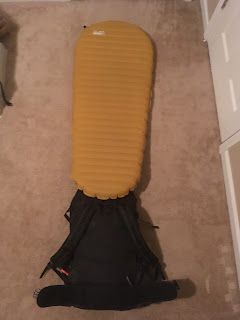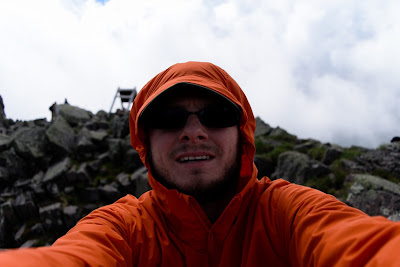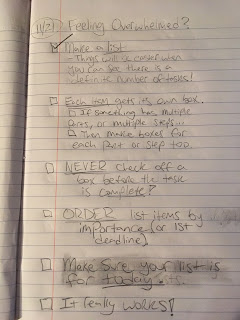Unexpected consequences of going lighter - equipment changes to make up for missing volume
The total number of items in my gear list is much lower than it used to be.
Why is this a problem?
As I've brought my base pack weight down, I've lost some of the utility provided just by having a greater number of items with me.
One example of this is that I used to ball up my extra clothing and use it as a pillow. As I've trimmed down my kit, a lot of that extra clothing isn't available anymore. I ended up getting an inflatable pillow for my birthday that weighed less, took up less room in my pack, and did a better job at being a pillow than my wad of unnecessary extra clothing. Now, with my pack volume lower than ever, I'm having the same problem again but with my sleeping pad setup.
 I used to use a foam, torso-length sleeping pad on the ground, extending the short pad with my backpack below my hips where it cut off, and it was great because my sleeping pad and backpack were at roughly the same level. Furthermore my 40 liter pack, which used to be my only pack, had a foam back-panel that did an excellent job replacing this "missing half" of the sleeping pad.
I used to use a foam, torso-length sleeping pad on the ground, extending the short pad with my backpack below my hips where it cut off, and it was great because my sleeping pad and backpack were at roughly the same level. Furthermore my 40 liter pack, which used to be my only pack, had a foam back-panel that did an excellent job replacing this "missing half" of the sleeping pad.
 On my recent trip to Knoxville to spend some time with one of my closest trail buddies I brought along my large-sized winter inflatable pad to serve as my bed. My buddy has almost no furniture, and his couch is super small. The large winter pad is super heavy, coming in at 20 ounces, and bulkier to pack up meaning that I almost never end up using it on trail. I slept so much more comfortably on the full-length pad that I'm pretty set on swapping to a full pad for my summer kit.
On my recent trip to Knoxville to spend some time with one of my closest trail buddies I brought along my large-sized winter inflatable pad to serve as my bed. My buddy has almost no furniture, and his couch is super small. The large winter pad is super heavy, coming in at 20 ounces, and bulkier to pack up meaning that I almost never end up using it on trail. I slept so much more comfortably on the full-length pad that I'm pretty set on swapping to a full pad for my summer kit.
Why is this a problem?
As I've brought my base pack weight down, I've lost some of the utility provided just by having a greater number of items with me.
One example of this is that I used to ball up my extra clothing and use it as a pillow. As I've trimmed down my kit, a lot of that extra clothing isn't available anymore. I ended up getting an inflatable pillow for my birthday that weighed less, took up less room in my pack, and did a better job at being a pillow than my wad of unnecessary extra clothing. Now, with my pack volume lower than ever, I'm having the same problem again but with my sleeping pad setup.
 I used to use a foam, torso-length sleeping pad on the ground, extending the short pad with my backpack below my hips where it cut off, and it was great because my sleeping pad and backpack were at roughly the same level. Furthermore my 40 liter pack, which used to be my only pack, had a foam back-panel that did an excellent job replacing this "missing half" of the sleeping pad.
I used to use a foam, torso-length sleeping pad on the ground, extending the short pad with my backpack below my hips where it cut off, and it was great because my sleeping pad and backpack were at roughly the same level. Furthermore my 40 liter pack, which used to be my only pack, had a foam back-panel that did an excellent job replacing this "missing half" of the sleeping pad.
Now, I've got a cuben fiber backpack without a foam back panel and I've switched to an inflatable pad for increased comfort. I was having some shoulder discomfort side-sleeping on my foam pad since it had compressed with several months of constant use, so rather than simply replace the foam pad I put that 40-something dollars into the purchase of my inflatable. I slept so much more comfortably that I was kicking myself for not having made this change sooner.
Everything was going fine with the new pad in the colder months, since I had my bigger pack and a bunch of extra equipment to fill it out out with, but moving to my summer kit two new issues have presented themselves. The worst of the two problems is that, while I can still pad my heels and/or ankles from the ground to increase my comfort, my legs hang off of my inflatable pad somewhat uncomfortably. It isn't uncomfortable immediately, but it adds up over the course of a night to become a little bit of a nuisance. I have ended up balling up on my torso-length inflatable to relieve the mild discomfort several times. The problem gets worse when my legs are sore from hiking longer days.
There just isn't anything left to pad my legs out with. My pack is almost like a trash bag folded up for all the cushioning it provides. The gear that could be stuffed into the pack is not anything comfortable to rest my legs on: toothbrush and toothpaste, phone and charger, head bug net, backup water treatment equipment, my wallet, my small rain jacket, and my toilet paper bag. The rain jacket, like the cuben fiber pack, is very thin and is only useful for padding out my heels from the floor. That's really all that's that's left to use after setting up camp.
I've thought about how to fix this problem with what's available to me in my gear list. The idea of building up a layer of duff and leaf litter under my bivy to support my legs did occur to me, and would be the only real in-the-field solution if the problem was bad enough, but I think there's a lot of increased risk of exposure to ticks and all the creepy-crawlies that live in the leaf litter in the woods with that solution. Camping on soft ground, though, is never really so bad as when I'm set up on harder surfaces like rock (rare) or the wood of a shelter floor.
I can, and have, put up with the mild discomfort but I'm thinking that if I frequently end up having to curl up in the fetal position on my torso pad there's a problem with my summer kit.
A lack of padding under my legs means both that my legs are no longer insulated from the ground and that my quilt doesn't always seal up around me properly above the foot box and below where it meets the pad. The effect of these two things is that my sleep system is a lot less comfortable on colder nights. My bivy prevents any real drafts from sweeping through my sleeping setup, but there's still a noticeably colder patch of air in this open space. This isn't a problem at all on warmer nights, but on the odd chilly night it can be annoying.
With the mild discomfort and the reduction in the warmth that occur when using the inflatable torso-length pad with my summer setup, it seems like I will have to switch out for a regular sized inflatable. Packing enough extra clothing to solve the problem, again, is going to add more unnecessary weight and do a worse job than dedicated sleeping pad will.
 On my recent trip to Knoxville to spend some time with one of my closest trail buddies I brought along my large-sized winter inflatable pad to serve as my bed. My buddy has almost no furniture, and his couch is super small. The large winter pad is super heavy, coming in at 20 ounces, and bulkier to pack up meaning that I almost never end up using it on trail. I slept so much more comfortably on the full-length pad that I'm pretty set on swapping to a full pad for my summer kit.
On my recent trip to Knoxville to spend some time with one of my closest trail buddies I brought along my large-sized winter inflatable pad to serve as my bed. My buddy has almost no furniture, and his couch is super small. The large winter pad is super heavy, coming in at 20 ounces, and bulkier to pack up meaning that I almost never end up using it on trail. I slept so much more comfortably on the full-length pad that I'm pretty set on swapping to a full pad for my summer kit.
My winter pad would be overkill for summer, and would increase my pack weight by too large of a percentage for me to seriously consider using it when I go out this May.
So, I'm looking for a new regular-sized sleeping pad.
The full-size version of my current inflatable is going to add about 4 ounces to my summer kit. Happily, this 4 ounce addition will not push me over the 5 pound "super ultralight" mark. I've been very happy with the performance and durability of the pad to date, and I'm sure that I'd be just as happy with the full-length version of the same pad, but I'm going to shop around pretty thoroughly and see if there are any other options that stand out.
I have a couple of months to get what ever I need, which is nice though probably unnecessary. When push comes to shove I know I'll go with the regular version of the pad I have if I'm not confident in the reviews for and features of what I find online.





Comments
Post a Comment
Hey, I appreciate you taking the time to comment. I hope you have a really good day.